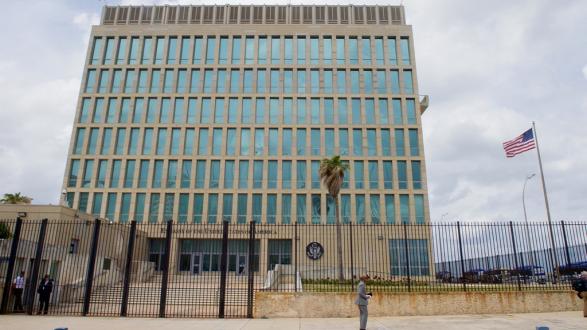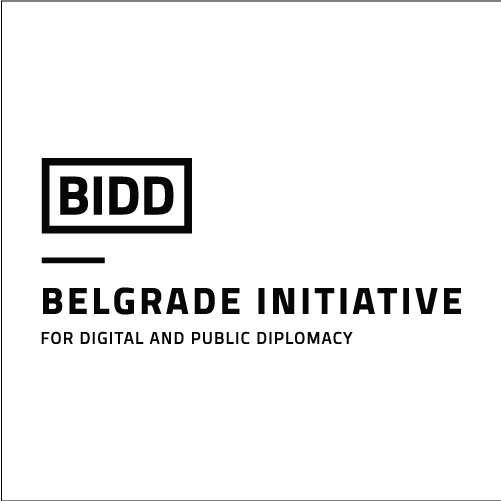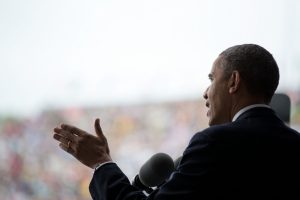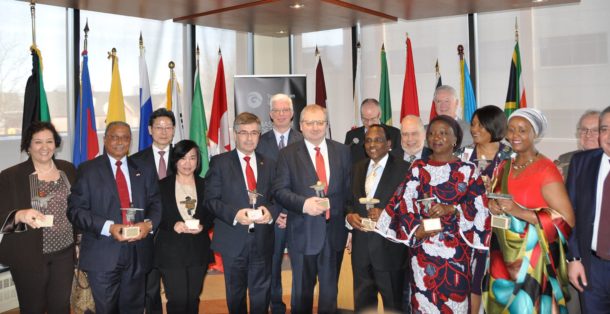pacificcouncil.org FEBRUARY 13, 2019By:
FEBRUARY 13, 2019By:
Mietek Boduszynski
In:
Middle East & North Africa
National Security & Defense
Foreign Policy & Diplomacy The securitization of U.S. diplomatic missions around the world remains a significant, even growing, challenge. Indeed, it is part of a larger phenomenon, one that preceded the Trump administration: the undermining of State Department influence and the militarization of U.S. diplomacy in the post-Cold War era, poignantly documented in the journalist Ronan Farrow’s recent book, War on Peace: The End of Diplomacy and the Decline of American Influence.These are realities that will outlast the Trump administration, and thus need to remain part of the discussion if America and Americans truly believe that diplomacy and public diplomacy [JB emphasis] should remain a central part of the national security toolkit.After 9/11, the securitization of U.S. diplomatic missions went far beyond moving embassies outside city centers and reinforcing them against attacks. Indeed, as U.S. foreign policy’s focus turned to the global war on terror, U.S. embassies, consulates, and other diplomatic outposts in conflict zones began to resemble military-forward operating bases.
The fortress embassy represents a culture that is preoccupied with security, inward looking, suspicious of locals, and unwilling to take any risks. The goals and operations of public diplomacy, by contrast, are outward looking and focused on engagement with local populations.
So was born the American fortress embassy. A fortress is variously defined as “a fortification, a defensive military construction;” “a military stronghold;” “a heavily protected and impenetrable building;” “a large and permanent fortification sometimes including a town;” or “a large, strong building or group of buildings that can be defended from attack.” The fortress embassy is all of these things, but it is also more than a set of physical structures and procedures designed to protect against attacks.In the figurative sense, it is also a space “not susceptible to outside influence or disturbance.” It therefore represents a culture that is preoccupied with security, inward looking, suspicious of locals, and unwilling to take any risks. The goals and operations of public diplomacy, by contrast, are outward looking and focused on engagement with local populations.On one level, the emergence of U.S. embassies in war zones reflected a push for the State Department to “step up to the plate” in the stabilization of Iraq, and later Afghanistan, after having a diminished role during the initial U.S. occupation of Iraq after 2003. This was particularly true as U.S. policy later turned to “nation building” measures in both Iraq and Afghanistan. But the need for a robust diplomatic presence went beyond this.
At the new “fortress embassies,” diplomats were severely constrained in their ability to leave the compound or to receive visitors, while military and intelligence personnel had much greater freedom of movement.
Diplomats were also necessary to provide support to extensive military and intelligence operations in Iraq and Afghanistan. For instance, diplomats in Iraq played a central role in negotiating the terms, length, and withdrawal of the U.S. military presence. Moreover, diplomats were needed in both countries to support various kinds of counterterrorism cooperation and operations.Yet, the increased presence of diplomats in war zones did not necessarily translate into enhanced influence for the State Department, much less effective diplomatic outreach. For one, the diplomatic presence was still overshadowed by the military in terms of personnel and capacity. Moreover, at the new “fortress embassies,” diplomats were severely constrained in their ability to leave the compound or to receive visitors, while military and intelligence personnel had much greater freedom of movement. And in any case, the movements of diplomats were subject to military escorts, or escorts by security contractors, most of whom were former military personnel.While public diplomacy officers were represented in Provincial Reconstruction Teams (PRTs) in Iraq and Afghanistan, there, too, they operated as part of military-dominant teams on military bases. As American diplomacy became increasingly militarized, many diplomats embraced the glamor and recognition afforded by serving in close proximity to and under the protection of their Department of Defense counterparts. Nevertheless, their ability to fulfill their diplomatic mandate suffered as a consequence.
Nearly everything about the fortress embassy model runs counter to the ethos of diplomacy—and especially public diplomacy.
By the end of the 2000s, the largest U.S. embassy in the world was located in Baghdad, Iraq. The new Baghdad embassy compound, which opened in 2009, was designed as a fortress within a fortress within the Iraqi capital’s heavily fortified “Green Zone.” This paradigmatic example of a fortress embassy cost $750 million to build and employed around 5,000 people. It continues to cost the U.S. taxpayer additional hundreds of millions of dollars a year to run, featuring a gleaming chancery, two sparkling swimming pools, tennis courts, a hospital, a state-of-the-art fitness center, a food court, and extensive well-kept lawns.In addition, well-appointed apartments were constructed for U.S. diplomats, while third-country contractors were given more austere, windowless temporary trailers. The embassy generates its own electricity and features water and sewage treatment facilities. The compound occupies an area larger than the Vatican City. If it were not for the ubiquitous blast walls and roving armed guards, it could be mistaken for an American college campus in a southwestern state like Arizona. But the question remains: how much diplomatic “bang” is the United States getting from spending so many “bucks” in such fortress embassy environments?Nearly everything about the fortress embassy model runs counter to the ethos of diplomacy—and especially public diplomacy. The security bubble, coupled with arduous procedures for entry and exit by embassy personnel reinforce the idea of complete separation from the local population. While citizens of the host country can theoretically visit fortress embassies, in reality very few beyond a small number of privileged elites ever do so. And the vast majority of staff working inside the fortress embassy never see the world beyond the walls.
In an environment with little to no appetite for risk, justifying any movement as “mission critical” becomes an impossible exercise, especially for public diplomacy practitioners.
“When you are posted to a fortress embassy,” one officer told me, “it is as if you are not really in that country.” For both the diplomat requesting access and the visitor who must brave multiple layers of security, the barriers to arranging in-person engagements are formidable. For local visitors, there is the humiliation of being subjected to multiple searches and waiting outdoors in the sun, rain, or cold. Furthermore, there are built-in risks for local visitors, who may be surveilled and reported on by exterior perimeter guards with links to groups hostile to the United States.As for the American staff, they must seek advance approval for external movements, justifying each of them as “mission critical.” Spontaneous engagements are usually off the table. A range of security considerations and at times limited security staff resources also result in restrictions on staff movements. In an environment with little to no appetite for risk, justifying any movement as “mission critical” becomes an impossible exercise, especially for public diplomacy practitioners. The public diplomacy mission is seen as vague and unnecessary in the eyes of many Diplomatic Security managers empowered to approve or deny external movements. This means that, at times, PD officers face greater obstacles in justifying their external movements as “mission critical.”What could so many staff members who are so limited in their movements possibly do on a daily basis at a fortress embassy? First, it is important to remember that the vast majority of staff members at fortress embassies are support and security staff, and not diplomats charged with any kind of engagement with the host country. This is because one of the primary functions of a fortress is force protection and management of what amounts to a self-contained small city. Accordingly, the jobs of most staff are devoted to running and protecting a complex operation composed of multiple agencies and organizations. In such an environment, much of the focus inevitably becomes inward looking.
It is difficult, from the perspective of both the stated mission of public diplomacy and the enormous expense to the U.S. taxpayer, to reconcile the number of U.S. diplomats at fortress embassies with the miniscule amount of face-to-face interaction they have with host country locals.
The fact that a relatively small number of diplomats focused on outward engagement are vastly outnumbered by security and support staff and restricted in their ability to leave the compound means that their traditional function—meeting with locals—become a rare, rather than daily, event. Instead, they rely on local staff to be their “eyes and ears” to the outside world, and instead busy themselves with administrative tasks wholly unrelated to their roles as public diplomats: personnel matters, internal embassy management, writing reports and cables, and bureaucratic wrangling with Washington.It is difficult, from the perspective of both the stated mission of public diplomacy and the enormous expense to the U.S. taxpayer, to reconcile the number of U.S. diplomats at fortress embassies with the miniscule amount of face-to-face interaction they have with host country locals.As a diplomat in Libya before the Benghazi attack, my work came up against the obstacles of the fortress embassy mentality. While playing tennis with the late Ambassador Christopher Stevens, I expressed my frustrations to him. He offered immediate support, reminding me, with characteristic but understated wit, that my craft is called “public” and not “private” diplomacy for a reason. Yet, it is also important to emphasize that State Department operations, and in particular public diplomacy of all types, have been necessarily constrained in high-threat posts.
What is the kind of relationship we want to have with Iraq and Afghanistan five, 10, or 20 years from now? Do we want relationships and people-to-people linkages that transcend our military involvement? How can the craft of public diplomacy help?
One cannot carry on business-as-usual public diplomacy in dangerous places. But, as I have argued in this study, a carefully considered, balanced approach to public diplomacy mission and goals is also limited by the fortress embassy mentality and model in ways that go beyond objective assessments of security risks. This is detrimental to U.S. goals in the countries where fortress embassies operate. This is because by design and by mentality fortress embassies have taken security to an extreme.It is terribly important to do public diplomacy in places such as Pakistan, Iraq, and Afghanistan. Beyond destroying the Islamic State and the Taliban and all the other “kinetic” things we want to accomplish in these places, what is the kind of relationship we want to have with Iraq and Afghanistan five, 10, or 20 years from now? Do we want relationships and people-to-people linkages that transcend our military involvement? Can we think about countering violent extremism and terrorism in other, non-kinetic ways? How can the craft of public diplomacy help?On one hand, public diplomacy practitioners have shown a remarkable ability to adapt to the fortress embassy model, using technology and other tools, as well as sheer determination and a willingness to push the limits and overcome the constraints. They have done extremely creative things to accomplish public diplomacy goals and implement public diplomacy programs. I know because I worked with such a public diplomacy officer in Iraq, Shana Kieran, who was able to open new channels of outreach and contact with Iraqi youth in spite of enormous challenges.
At fortress embassies in challenging security environments, it requires a rethinking of the balance between security and mission so as to meet the public diplomacy goals of meaningful people-to-people engagements, building long term relationships, and preparing a foundation for long term trust and goodwill.
Meanwhile, missions and the Bureau of Educational and Cultural Affairs have been creative in coming up with virtual programs, taking advantage of technology. There are virtual speaker programs, school-to-school linkages, and even an interactive walking tour (in real time) of New York City that the U.S. Embassy in Islamabad hosted to highlight different ethnic neighborhoods, thereby showing the value of diversity and the United States as a nation of immigrants. In other words, social media and internet technology can help overcome some of the limits of fortress embassies. But they also have limits.As retired Ambassador Prudence Bushnell, who was chief of mission in Nairobi at the time of the embassy bombing there, told journalist Robert Worth, “No one has sat back to say, ‘What are our objectives?’ The model has become, we will go to dangerous places and transform them, and we will do it from secure fortresses. And it doesn’t work.”At fortress embassies in challenging security environments, it requires a rethinking of the balance between security and mission so as to meet the public diplomacy goals of meaningful people-to-people engagements, building long term relationships, and preparing a foundation for long term trust and goodwill.________________________Mieczyslaw Boduszynski is a Pacific Council member, an assistant professor of international relations at Pomona College in California, and a former American diplomat with the State Department.This piece was originally published as part of the USC Center on Public Diplomacy Perspectives series, December 2018.The views and opinions expressed here are those of the author and do not necessarily reflect the official policy or position of the Pacific Council.Original Article












